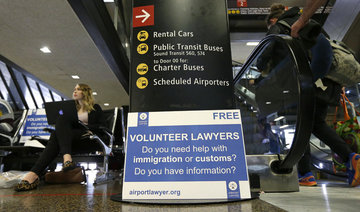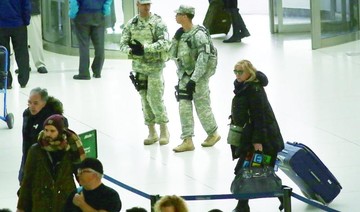KABUL/PESHAWAR: The main border crossing between Afghanistan and Pakistan has been closed, officials from both sides confirmed on Monday, with reports of authorities exchanging gunfire amid worsening relations between the two neighbors.
Afghan authorities closed on Sunday the Torkham border crossing over Pakistan’s alleged refusal to facilitate trade transport and Afghan patients, Taliban officials confirmed with Arab News.
“Doors have been shut down due to some issues,” Qazi Mullah Adil, governor spokesman of Afghanistan’s Nangarhar province, told Arab News.
The Torkham border crossing, a key point of transit for travelers and goods, is located in Pakistan’s northwestern Khyber Pakhtunkhwa province and the eastern Afghan province of Nangarhar.
“There were a lot of problems when Afghans were traveling,” Adil said.
“There was no clash,” he added. “Only one gunfire (exchange) took place, nothing else.”
Sedidullah Quireshi, deputy spokesman of Nangarhar’s information and culture department, said the crossing point has been closed since Sunday evening.
“The Pakistani side did not meet their commitments. They had promised to provide facilities for trade transport and patients. Thus, the gateway has been shut down on the directions of our leadership,” he told Arab News.
Quireshi said the closure will be temporary until the issue is resolved between officials of the neighboring countries.
“Talks are underway with Pakistani authorities regarding the issue,” he said.
Residents from both countries and Pakistani officials said gunfire erupted early on Monday.
Akbar Khan Afridi, a senior police officer in the Pakistani town of Landi Kotal, near the Torkham border, said “there was gunfire in the morning.”
Though the situation was relatively calm when the border crossing closed on Sunday evening, gunshots were heard the next day.
“Monday morning, the Pakistani security forces started firing from their check posts toward the Afghan side,” Pacha, a resident of the Afghan town Torkham, told Arab News.
The situation was quiet by Monday afternoon, said Irshad Mohmand, assistant commissioner of Pakistan’s Khyber district.
“It’s calm now, the ceasefire is intact, and the gate is closed for all sorts of vehicular and pedestrian movements,” Mohmand told Arab News.
At least one person was injured, Mohmand said.
Cross-border fire and shootouts have occurred along the Afghan-Pakistan border for years. In the past, each side has closed Torkham and the Chaman border crossing in southwestern Pakistan, for various reasons. For landlocked Afghanistan, both crossings are vital for both trade and travel.
Pakistan has witnessed since November a surge in militant attacks, when the Pakistani Taliban — the outlawed Tehreek-e-Taliban Pakistan or TTP — ended a months-long ceasefire with the government. The TTP is a separate militant group that openly pledged allegiance to the Afghan Taliban after the fall of Kabul in 2021.
Since the Taliban takeover, Pakistan has allowed critically ill or injured Afghans to enter the country for medical treatment, though, like many other countries, it still does not recognize Afghanistan’s Taliban government.



























